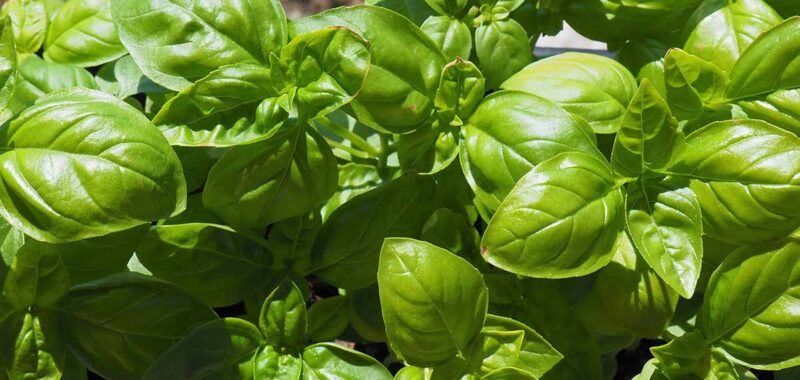Ocimum basilicum ‘Genovese’
Fragrant, fast-growing, and a delight in the kitchen, ‘Genovese’ basil is an easily cultivated and rewarding herb for the gardener and cook alike!
It’s the traditional Italian herb used to create the very best pesto. This preferred variety has large, sweet leaves, is slow to bolt in extreme heat, and does not become bitter with age.
More aromatic than the sweet variety, the large, shiny leaves are a distinct almond shape with a sweet, peppery flavor and notes of anise, cloves, and mint.


We link to vendors to help you find relevant products. If you buy from one of our links, we may earn a commission.
The fast-growing plants are frost-tender perennials, commonly grown as annuals. They are ideal for containers or garden beds in any sunny location. And the handsome, deep green leaves release a delightful, spicy fragrance when touched.
Tall spires of white flowers are magnets for pollinators like bees, butterflies, and hummingbirds, and being an open-pollinated cultivar, seed collection produces plants true to the parent.
It’s also a popular companion plant for vegetables and often used for its pest-repellent or flavor-enhancing properties with plants such as tomatoes, peppers, and root veggies like carrots.
The superb flavor is a natural in many recipes other than pesto, including fish and seafood dishes, pasta, pizza, salads, sauces, and more. Plus, it retains flavor well when frozen.
Fast-growing, flavorful, and fragrant, you’ll love this herb in your garden!
Now, let’s dig into the easy steps on how to grow ‘Genovese’ basil.
Here’s what we’ll cover:
Also known as heirloom, Italian, or traditional basil, ‘Genovese’ is a cultivar of the sweet species plant, Ocimum basilicum.
Quick Look
Common name(s): Genovese basil, common basil
Plant type: Perennial herb, grown as an annual
Hardiness (USDA Zone): 10 and up (for overwintering outside)
Native to: Italy
Season: Summer
Exposure: Full sun
Soil type: Rich, loamy, well draining
Soil pH: 6.0-7.5, slightly acidic to slightly alkaline
Time to maturity: 60-90 days
Spacing: 4-8 inches in rows, closer in containers
Planting depth: 1/2 inch (seeds)
Mature size: 10-16 inches wide x 2-3 feet high
Water Needs: Moderate
Taxonomy
Order: Lamiales
Family: Lamiaceae
Genus: Ocimum
Species: basilicum
Cultivars: Genovese
A member of the mint (Lamiaceae) family, this aromatic culinary herb grows two to three feet in height and has large, tender leaves in rich shades of jade green with a bright, spicy-sweet flavor.
The zesty taste includes notes of anise, cinnamon, cloves, and mint and the pretty plants emit an equally enticing fragrance when the leaves are touched.
A frost-tender perennial, these plants are commonly grown as annuals and need warm weather to thrive – cool, moist conditions at 50°F and below can cause damping off, gray mold, and generally sulky behavior.


But they can still be cultivated year-round by bringing in a pot before the first frost or starting new plants indoors over winter.
However, they will still need at least six hours of strong light – and a simple, full spectrum grow light makes a continuous harvest easy.
Thankfully, the days of glaring bare bulbs with an industrial wire clamp are long gone and there are plenty of attractive setups available for indoor cultivation – check out a few options in our guide to the best grow lights.
Cold-hardy only in USDA Zones 10 and above, ‘Genovese’ is the star of the traditional green Italian sauce, pesto alla Genovese.
And it’s also used in a wide variety of dishes as well as sauces and beverages, like eggs, fish and seafood, pasta, poultry, vegetable and tomato dishes, salads, smoothies, and vinaigrettes.
How to Sow
‘Genovese’ is easily propagated by seeds or stem cuttings.
An open pollinated (OP) cultivar, seeds produce plants true to the parent – so be sure to read our guide on how to harvest and save your own basil seed to preserve your own stock for planting.
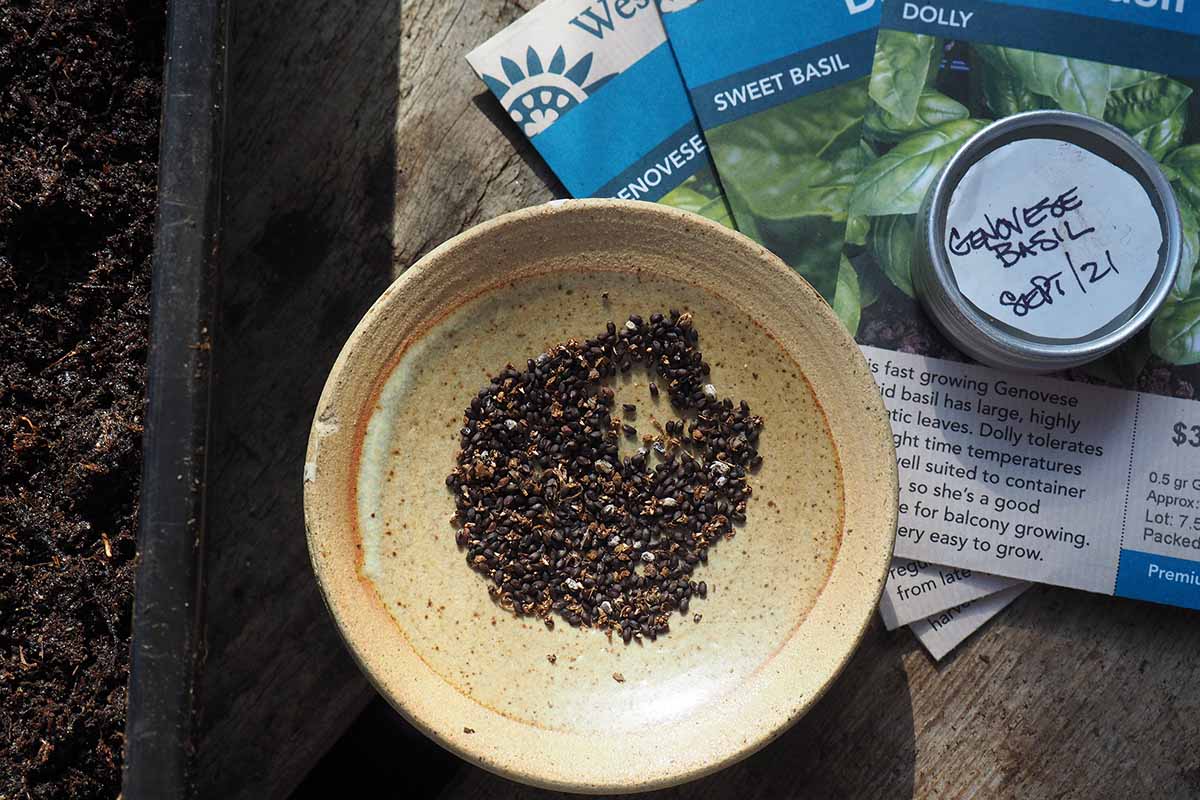

Start seeds early indoors in small pots or trays and transplant your seedlings out once warm temperatures arrive. Successive crops can be started outdoors from late spring through summer.
For germination and active growth, temperatures must be above 50°F. But the closer to 50°F the temperature is, the slower growth will be – basil really prefers warmer temperatures and thrives in the range of 70 to 90°F.
Here’s how to plant them:
- Sow seeds half an inch deep and keep the soil moist for germination, which should occur in five to 10 days.
- When plants are four to six inches tall, pinch out the growing tips just above the second set of leaves. This encourages branching and bushy growth.
- Transplant into larger containers or garden beds after pinching out the tops.
For easy propagation steps, read this guide on how to propagate basil – it has all the details for starting plants from seeds and stem cuttings.
How to Grow
Genovese basil is one of the easiest herbs to cultivate, whether you’re filling out a kitchen windowsill, a raised bed, or a patio container.
With just a little warmth, sun, and regular care, you’ll be rewarded with lush, aromatic leaves perfect for everything from pesto to caprese salads.
Light
This plant thrives in full sun, needing at least six to eight hours of direct light per day. If you live in an exceptionally hot area, a bit of afternoon shade can help prevent the leaves from scorching.
Indoors, be sure to place pots in a bright, south-facing window or supplement with grow lights if necessary. Without sufficient light, plants may become leggy and produce fewer leaves.
Soil
Plant Genovese basil in rich, well-draining soil with a slightly acidic to slightly alkaline pH between 6.0 and 7.5.
Amend garden beds and container soil with organic matter such as aged compost or well-rotted manure. And sprinkle in a bit of bone meal for strong roots.
If you’re growing in a container, opt for a high-quality, moisture-retentive potting mix formulated for herbs or vegetables


Temperature and Humidity
Basil loves warmth and sulks in the cold. Ideal daytime temperatures range from 70 to 85°F. At night, try to keep the temperature above 50°F.
If a chilly night is expected, cover outdoor plants to protect them.
Basil also prefers moderate humidity levels but is adaptable, thriving without much fuss as long as temperatures are warm.
Water
Keep the soil consistently moist, but never soggy. Water when the top inch of soil feels dry to the touch.
Always water at the base of the plant rather than overhead to avoid promoting fungal diseases.
If you’re growing in containers, keep in mind that potted plants dry out faster and will need more frequent watering, especially during hot spells. Add a moisture-retentive material like coconut coir, peat moss, perlite, or vermiculite to resist drying out.
Using a saucer under pots can also help hold onto moisture on hot summer days.
Find more tips on watering basil plants here.
Fertilizer
Basil isn’t particularly greedy, but it benefits from a light, steady supply of nutrients.
Feed plants in garden beds and containers with a balanced fertilizer every three to four weeks. For indoor plants, feed less frequently, or every four to six weeks.
Avoid over fertilizing, especially with high-nitrogen fertilizers, as this can encourage lush foliage at the expense of flavor.
Container Growing
Genovese basil is an excellent candidate for container growing. Choose a pot that’s at least eight to ten inches wide with good drainage holes.
Use a rich potting mix that retains moisture without becoming waterlogged.
Container-grown plants will need to be watered more frequently than those in the ground. Regular pinching will help keep plants compact and encourage bushy, lush growth.
Pinch Out Flowers
Also, to keep plants producing tasty leaves, pinch out the edible flower buds as they appear. But be sure to cut or pinch the stem below the buds – if only the bud tips are pinched, new ones reappear quickly.
Successive Plantings
Depending on how much of an herbivore you are, successive plantings are a smart idea – because there’s nothing worse than running out!
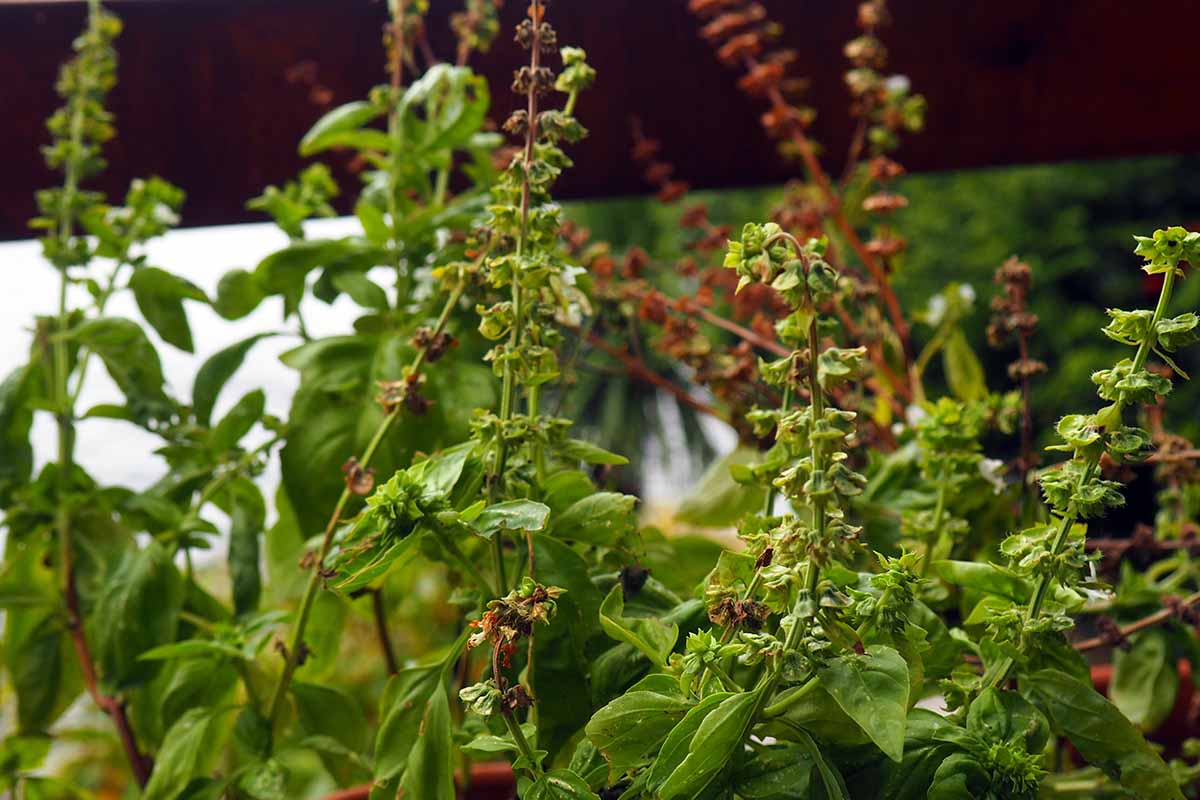

For a steady supply of leaves (and plenty for freezing), start a series of containers or short garden rows, sowing three or four weeks apart.
Harvest the large leaves from the first pot or row, then move on and harvest the second, then third, and so on. As you continue to harvest successively, return to the earlier-picked plants for a second and third harvest.
And if you do want to collect seeds, allow a few plants to flower freely.
For a bountiful seed harvest, choose plants from an early crop. Seeds from later crops (sown from midsummer on) can still be green when a killing frost arrives, and ideally, you want them to ripen and dry in the late summer sun.
Overwintering
Basil is a tender annual in most climates and will not survive a frost. To extend the harvest, you can pot up healthy plants and bring them indoors before temperatures dip below 50°F.
Place them in a sunny window and keep them away from cold drafts. Alternatively, take cuttings to root indoors over winter, ensuring a fresh supply until it’s time to plant again in spring.
Cultivars to Select
Highly popular in the herb garden, seeds and plants are widely available in garden centers and online. Here are a few options to get you started:
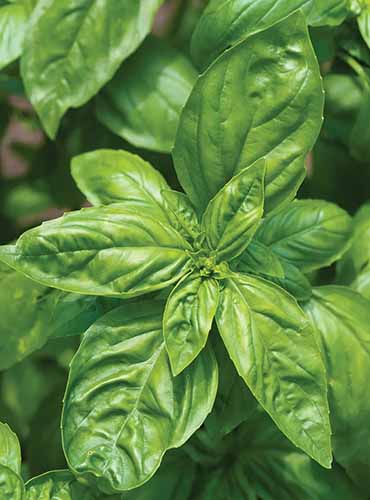

‘Genovese’
You can find certified organic ‘Genovese’ seeds and plants at Burpee.
Organic seeds in packets or in bulk are available at True Leaf Market.
And large and small packets of organic, heirloom seeds are available at Botanical Interests.
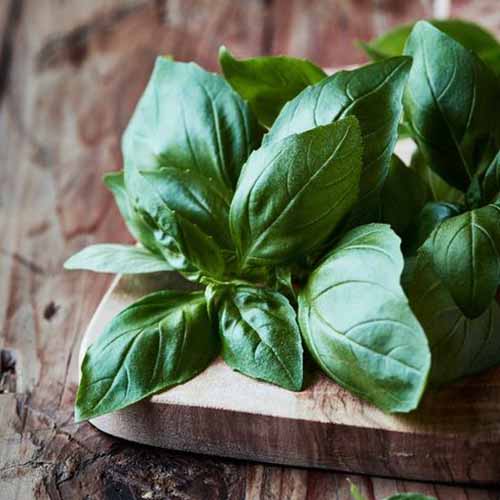

‘Italian Large Leaf’
‘Italian Large Leaf’ is another cultivar very similar to ‘Genovese’ with large, tender leaves. Seeds by the packet or in bulk are available at Eden Brothers.
Or you can pick up ‘Italian Large Leaf’ plants in six-inch pots at Home Depot.
Pests and Disease
‘Genovese’ is generally hearty, but a few common pests and diseases can be problematic.
Sap-sucking aphids can damage the stems but these can be carefully knocked away from sturdy plants with a strong spray of water. An insecticidal soap or neem oil can be used for dense infestations.
Slugs and snails also enjoy this tasty herb in their diet. Locate plants in a full sun location to discourage visits and hand pick gastropods to dispose of them – or use one of the other solutions in our guide on how to protect your garden from slugs and snails.
Fusarium wilt (Fusarium oxysporum f. sp. basilicum) is a common fungal problem along with damping off (Rhizoctonia solani) and gray mold (Botrytis cinerea).
Ensure clean, sterile soil is used to prevent the spread of soil-borne pathogens like fusarium wilt. Give plants adequate air circulation and a warm environment to avert conditions like gray mold and damping off.
Harvest and Storage
Once plants are about six inches tall, nip stems just above the second set of leaves to encourage branching and bushier plants.
After that, pinch off the end growth from the longest stems as desired. These pruning practices help your herbs to thrive, but they double as proper harvesting techniques!
Fresh ‘Genovese’ basil is always best, but leaves retain their flavor well when frozen.
And although they do darken in color and become a little mushy after freezing, they’re great for adding flavor to sauces, soups, stews, and other cooked dishes. Our guide on how to freeze herbs has all the steps you’ll need.
You can also dry the leaves and we have a guide for that too!
Fantastic Flavor
For fantastic flavor, spicy fragrance, and easy cultivation, ‘Genovese’ is the cultivar to choose.
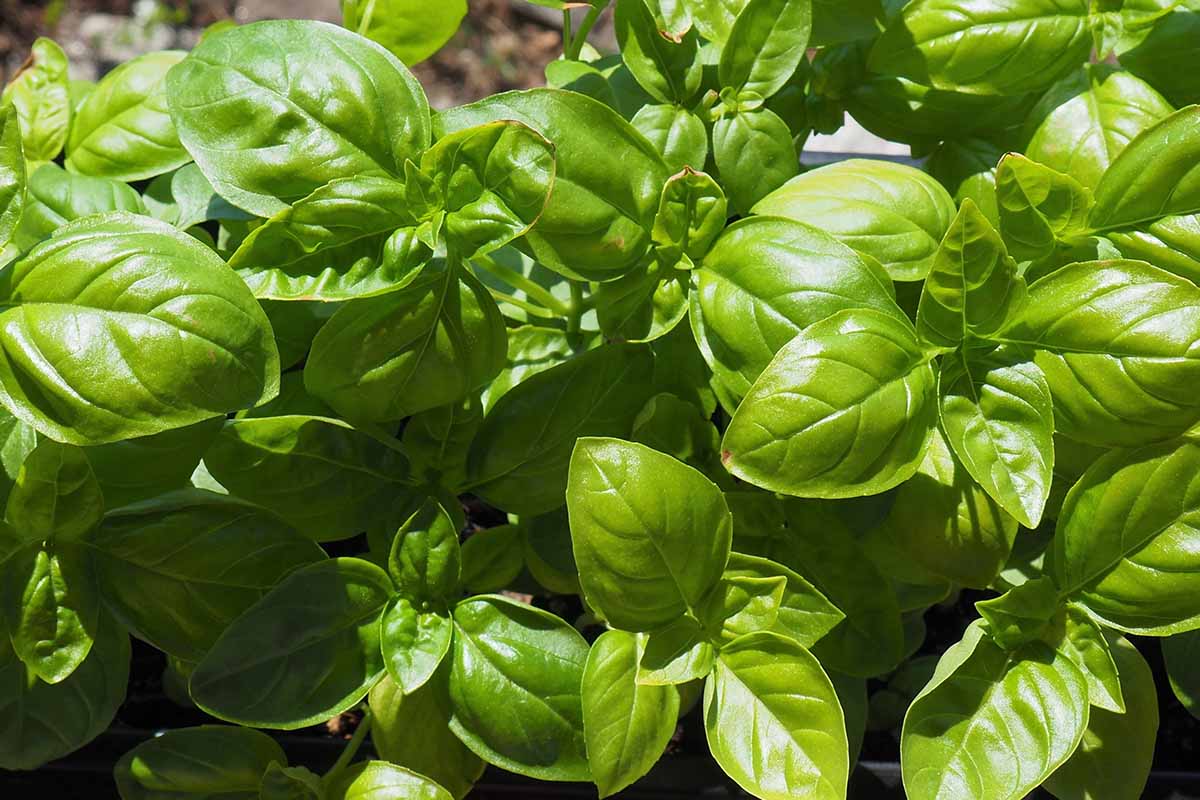

Fast-growing and wonderfully rewarding, start seedlings early indoors and then move them to a sunny spot in the garden when reliably warm temperatures arrive.
But be warned, you’ll harvest these tasty leaves as fast as they grow – so plant successively throughout summer for a continuous supply!
How do you folks like to use ‘Genovese’ basil? Tell us about it in the comments section below.
And for even more options to enjoy delicious basil at home, read these guides next:

